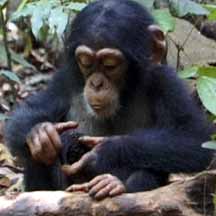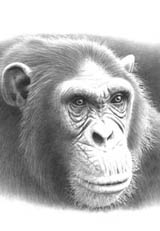Many animals, ranging from the rat to the puffer fish, have had their genome sequenced, and now humankind's closest living relative, the chimpanzee, has joined the group. The publication of a draft sequence of the animal's genome, today in the journal Nature provides the most detailed look yet at the similarities, and differences, between humans and chimps. Previous studies comparing DNA between the two analyzed randomly selected regions of the genetic codes that comprised around 500 base pairs each. The Chimpanzee Sequencing and Analysis Consortium, made up of 67 scientists from around the world, set out to catalogue the chimp's entire genome, which contains some three billion base pairs. The researchers studied the DNA of Clint, a male chimp that lived at the Yerkes National Primate Research Center in Atlanta, Ga., until he passed away at the age of 24. Using the shotgun sequencing approach, they mapped 94 percent of the genome with a high degree of certainty, covering some parts of the sequence three or four times. Chimp Genome--and First Fossils--Unveiled
The scientists compared the chimp genome to the human one, focusing on points at which the two differ. When considering substitutions of one base pair for another, the results indicate that about 1.2 percent of the genomes are different, which agrees with past estimations that chimps and humans share upwards of 98.5 percent of their DNA. But when the investigators considered duplications and rearrangements of larger sections of the genetic code as well, they found an additional 2.7 percent difference between the two genetic blueprints. "Over the new few years, such a comparison will allow us to learn more about how our own genome has evolved and gain a better understanding as to why we get cancers and other diseases that chimpanzees very rarely suffer," explains Richard K. Wilson of Washington University, a co-author on one of the papers. Humans are believed to have diverged from chimps between roughly six million and seven million years ago. By studying the chimp genome, scientists hope to better understand our own biology and what sets humans apart. "As more is learned about other functional elements of the genome, we anticipate that other important differences outside of the protein-coding genes will emerge," remarks co-author LaDeana W. Hillier, also at Washington University. So far, the team has identified six regions of the human genome that suggest they underwent mutations so advantageous that it took just a few hundred generations for them to become entrenched in the entire population.
In the same issue of Nature, researchers report having found the first chimpanzee fossils. The remains are scant--just three teeth--but they have led to an intriguing revelation about our closest living relative. Today's chimps are confined to the woodlands of west and central Africa. Most hominid fossils, on the other hand, have turned up in the semiarid East African Rift Valley. Some scholars thus posited that ancient chimps and humans probably did not overlap geographically, and in fact might have diverged from their common ancestor when East Africa began to dry out, with chimps heading for the lusher areas and hominids taking over the grasslands to the east. Indeed, once ancestral human and chimp populations separated, so one hypothesis goes, the Great Rift Valley itself might have barred chimps from moving into East Africa.
In the same issue of Nature, researchers report having found the first chimpanzee fossils. The remains are scant--just three teeth--but they have led to an intriguing revelation about our closest living relative. Today's chimps are confined to the woodlands of west and central Africa. Most hominid fossils, on the other hand, have turned up in the semiarid East African Rift Valley. Some scholars thus posited that ancient chimps and humans probably did not overlap geographically, and in fact might have diverged from their common ancestor when East Africa began to dry out, with chimps heading for the lusher areas and hominids taking over the grasslands to the east. Indeed, once ancestral human and chimp populations separated, so one hypothesis goes, the Great Rift Valley itself might have barred chimps from moving into East Africa.
The new discovery, made by Nina G. Jablonski of the California Academy of Sciences and Sally McBrearty of the University of Connecticut, refutes that idea, showing that chimps lived alongside an extinct species of Homo in Kenya roughly half a million years ago. Judging from the remains of hippos, crocodiles, catfish and other bones found at the site, the two appear to have inhabited a wet, wooded area surrounding a lake. The chimpanzee's preference for wooded environs may explain the paucity of fossils belonging to these creatures: bones do not preserve well in wet habitats. That said, now that fossil chimps have been identified in this region, more may be recognized, the authors conclude. Indeed, it is possible that humans have shared the landscape with their closest living relative ever since they started down separate evolutionary paths. --Sarah Graham and Kate Wong
HOME
Primate Info
Animal Medicine
Primate Species
Animal Rights FAQ
Chimpanzee Hotlinks
Retired Chimpanzees
Self-medicating lemurs
Chimpanzee Fact Sheet
The chimpanzee genome decoded
dave@bltc.com

